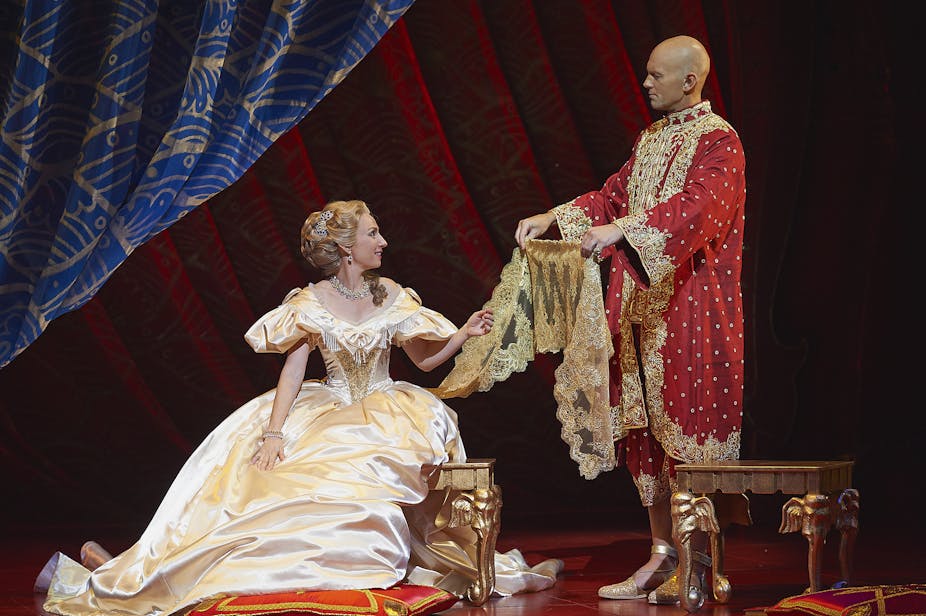Why is Opera Australia staging The King and I? The Rodgers and Hammerstein favourite is currently playing at the Sydney Opera House and has been a remarkably successful choice, commercially speaking. Even though reviewers have questioned the casting of the fair-skinned New Zealander Teddy Tahu Rhodes as the Thai lead, the King of Siam, ticket sales have been strong.
Opera Australia receives the most generous state subsidy of all the performing arts organisations in Australia (A$25.2 million in 2013) – and its brief is, one might think, to stage operas not musicals. So, with that in mind:
Should a subsidised company present a work that falls squarely within the ambit of commercial theatre?
-
Where do the boundaries between opera and musicals actually lie?
The first question is fairly easily addressed. Frequently, opera companies are turning to the more commercial side of musical theatre, and that’s not new.
In Europe, and particularly in the German-speaking opera houses, American musicals have long been staple fare. Often the smaller theatres stage West Side Story, The Sound of Music, Showboat, Carousel and many other similar shows, usually in German.
And this in addition to the standard German-language operettas such as The Merry Widow, Die Fledermaus, and The Land of Smiles, which have held sway for more than a hundred years. Of course, let’s not forget that the German theatres are far more heavily subsidised by the state than Australia.
Last year’s production of South Pacific by Opera Australia is another example of tackling more commercial fare. There’s a long tradition of Gilbert and Sullivan in the company’s repertoire, but the work of Gilbert and Sullivan has lost some of its appeal – thus the move to classical American musicals.
The repertoire is vast and rich.
After the second world war, opera followed the lead of classical music in general into what might be regarded as hardcore modernism. While some masterpieces emerged, most of the operas staged in the 30-odd years after 1945 have disappeared (the works of Benjamin Britten are the outstanding exception – but he was never a committed modernist).
Audiences voted with their feet and stayed away in droves. The days of leaving a performance remembering, never mind whistling, the tunes seemed long gone. Composers often treated their singers with disdain, viewing the glories of the trained operatic voice as just another instrument in their orchestral palette, rather than the essence of the art form.
Predominantly in America, composers emerged who resisted this often academic orthodoxy and sought to remake opera as the popular form it once was. They “rediscovered” tonality, writing works that gave prominence to beautiful singing as well as respecting contemporary dramatic fundamentals.
One early exponent was composer Carlisle Floyd, who never really moved away from traditional dramaturgy and musical structures. His Of Mice and Men adaptation, very successfully staged by Opera Australia in 2011, is a case in point.
There are many other younger composers – such as John Harbison (The Great Gatsby), William Bolcom (A View from the Bridge), Tobias Picker (An American Tragedy), Jake Heggie (Dead Man Walking; Moby Dick), Ricky Ian Gordon (The Grapes of Wrath), Mark Adamo (Little Women) – who have drawn on celebrated literary works for their sources and enjoyed considerable success.
Another significant strand in American classical music is minimalism.
The two great exponents are the enormously prolific composer Philip Glass, who has had four operas staged in Australia this year, including his take on Walt Disney in The Perfect American, recently mounted in Brisbane, and the Portrait Trilogy of operas performed in Adelaide.
Composer John Adams is the other important so-called minimalist, whose three major works – Nixon in China, The Death of Klinghoffer, and Dr Atomic – have courted controversy while enjoying great critical acclaim and box-office success.
Many of those works suggest the rigid boundaries between opera and the musical are increasingly porous. American opera composers have not been afraid of deploying arias that resemble the anthemic “big number” of the musical (itself based on the operatic aria). But the current relationship between these art forms is symbiotic. Several of the great musical hits in the last decades of the 20th century were “operatic” in conception – just think of Sweeney Todd, Jesus Christ Superstar, Evita, Phantom of the Opera, and Les Miserables.
So where to with contemporary Australian opera?
The Iain Grandage/ Alison Croggon adaptation of Tim Winton’s novel The Riders is currently being staged by Victorian Opera and enjoying great success. In it, a tautly constructed and poetic libretto is allied to evocative, eclectic, yet highly wrought music, which results in an evening of rare intensity.
Grandage understands and writes well for the operatic voice, which is underpinned by orchestral forces employing an unusual range of instruments, resulting in expressive, often demanding and hauntingly beautiful music.
This is the direction opera in Australia must pursue, encouraging gifted and innovative young composers to tackle this most daunting of art forms, rather than seeing new works as box-office poison.
Musicals can and must cross-subsidise such new works if the art form is to survive.

